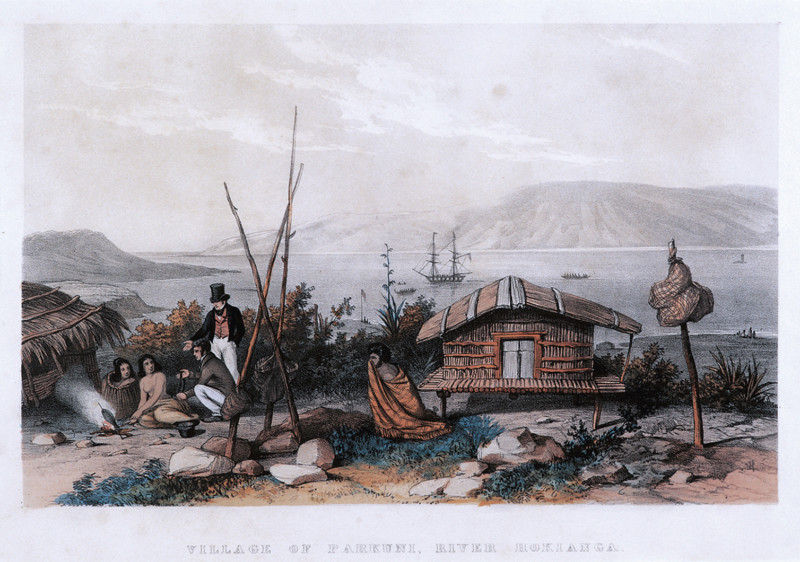EARLE, Augustus;
Village of Pakanae, River Hokianga
1838
Hand-coloured lithograph on paper
228 x 398mm

Original title: ‘Village of Parkuni, River Hokianga’. Plate No. 4 from Augustus Earle, Sketches Illustrative of the Native Inhabitants and Islands of New Zealand (London: Robert Martin, 1838).
The following text comes from the catalogue for the exhibition Tirohanga Whānui.
Here, at Pakanae, two Europeans, one in top hat and waistcoat, the other more informally dressed, are conducting some kind of negotiation involving a ribbon with two Māori women, one of whom is bare-breasted. They are observed by a seated Māori figure wrapped in a blanket, which he has drawn up to his face—in dismay? Is this work the record of some sexual bargain or, more innocently, a marriage proposal, or a simple commercial transaction?
This lithograph is one of ten from Sketches Illustrative of the Native Inhabitants and Islands of New Zealand, published in London in 1838 under the auspices of the New Zealand Association by Robert Martin & Co.
Such collections had a ready sale either to those with a then fashionable taste for representation of encounters between Europeans and ‘savages’ or those impelled by the colonizing urge. Earle was a keen observer of such phenomena, though in this case the lithograph shows a domestic scene that belies his own written descriptions.
Earle was an itinerant artist who travelled widely after 1815, reaching Brazil by 1820. He worked in Rio de Janeiro for a period, and, in 1824, voyaging to Calcutta, he spent eight months on Tristan da Cunha, having been abandoned there. He was eventually rescued by a ship bound for Tasmania and found his way to Sydney, where he lived for two years.
In October 1827, he sailed to Aotearoa, where he spent eight months in the area between Hokianga and the Bay of Islands. Openly living with Māori, he incurred the displeasure of missionaries, in turn criticizing them for their prudish imposition of Western clothing on a people he admired for their ‘natural elegance and ease of manner’.
In 1831, Earle joined the Beagle, also carrying the young Charles Darwin, on its voyage to chart the South American coastline. He became ill at Montevideo and was forced to leave the ship in August 1832. In the same year, he published the still highly readable A Narrative of a Nine Months’ Residence in New Zealand in 1827.
Exhibition History
Tirohanga Whānui: Views from the Past, Te Kōngahu Museum of Waitangi, 15 April to 15 September 2017
Te Huringa/Turning Points: Pākehā Colonisation and Māori Empowerment, Sarjeant Gallery Te Whare o Rehua, Whanganui, 8 April to 16 July 2006 (toured)
Provenance
1995–
Fletcher Trust Collection, purchased August 1995

